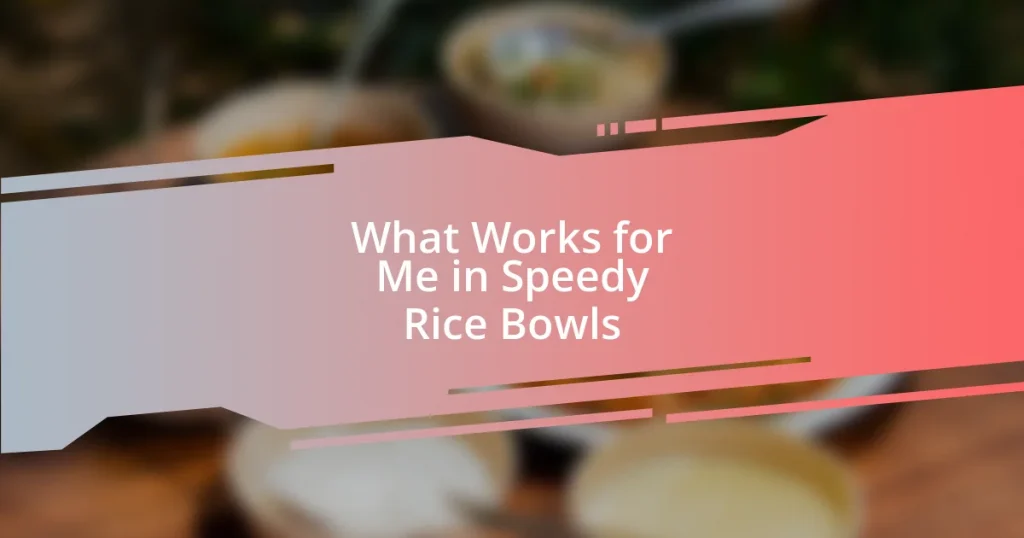Key takeaways:
- The right dough balance is crucial; use all-purpose flour for versatility, and control water and resting time for optimal texture.
- Perfect filling requires a mix of fresh herbs, moisture control, and tasting as you go to adjust flavors before wrapping.
- Experiment with cooking methods and fillings, and pay attention to details in presentation and sauces to enhance the dumpling experience.

Essential Dumpling Ingredients
When it comes to dumpling ingredients, the dough is absolutely crucial. I remember the first time I attempted making dumplings from scratch; I was overwhelmed by how a simple mixture of flour and water could transform into something so delightful. The key is to find the right balance—too much water, and your dough will be sticky and hard to work with; too little, and it will crumble apart. Isn’t it amazing how balanced proportions can make or break your dish?
Now, let’s talk about fillings. This is where creativity can truly shine. From classic pork and chive to unconventional options like mushroom and spinach, every combination brings a unique flavor profile. I once threw together leftover veggies and some minced meat, hoping for the best, and ended up creating a filling that became a family favorite. Have you ever had an unexpected ingredient lead you to a delicious revelation?
Lastly, don’t underestimate the power of seasonings. Whether it’s ginger, garlic, or a splash of soy sauce, these elements elevate your dumplings to a whole new level. I’ve often found myself tasting the filling and thinking, “It needs a little something,” before adding just the right pinch of salt or a drizzle of sesame oil. Isn’t it interesting how a single ingredient can change the entire dish’s character?

Choosing the Right Dough
Choosing the right dough is like laying the foundation for a beautiful structure; it can really make or break your dumplings. I’ve experimented with different types of flour and discovered that using all-purpose flour gives a versatile dough that holds up well whether you’re boiling, pan-frying, or steaming your creations. The texture should be smooth and slightly elastic, which is a joy to work with. I remember the first time I tried using rice flour instead of my usual choice—it was a complete game changer, though it took me a while to get used to its more delicate nature.
Here’s what I consider when selecting my dough:
- Type of Dumpling: Different dumplings, like wontons or gyozas, call for distinct dough characteristics.
- Texture: A well-made dough should feel soft but firm, allowing for flexibility without tearing.
- Water Content: The ratio of water to flour is critical; a hydrating dough typically yields a tender result.
- Resting Time: Giving your dough time to relax develops gluten, leading to a more chewy texture.
- Personal Preference: Ultimately, what works for me might not work for everyone—don’t hesitate to experiment until you find your signature dough!
Each little detail matters, and finding the right combination sometimes feels like uncovering a hidden treasure in your kitchen.

Techniques for Perfect Filling
Creating the perfect filling for dumplings is a delightful journey in itself. One technique that I swear by is to use a mixture of fresh herbs and aromatics. For instance, I always toss in a handful of chopped cilantro or scallions because their bright flavors uplift the filling. The first time I did this, I was amazed at how it transformed my dish from good to unforgettable!
Another important aspect is moisture control. It can be a slippery slope; you want the filling to be juicy, but not overly watery, which could lead to soggy dumplings. I learned this the hard way with a batch of chicken dumplings that ended up bursting. Now, I meticulously squeeze out excess liquid from vegetables like zucchini or mushrooms before mixing them in. Have you ever had a filling turn your perfect dumpling into a sad mess? Trust me, finding that balance is key!
When experimenting, it’s helpful to taste as you go. I always set a small portion aside and pan-fry it to see how the flavors meld. This allows me to adjust seasoning before wrapping everything up. Once, midway through my process, I realized I hadn’t added enough salt, and a simple pinch made all the difference. I encourage you to trust your instincts; your personal touch is what will make your dumplings shine.
| Technique | Details |
|---|---|
| Incorporate Fresh Herbs | Brightens flavors and adds freshness. |
| Moisture Control | Prevents soggy dumplings; remove excess liquid. |
| Taste as You Go | Adjust seasoning and flavor balance before wrapping. |

Cooking Methods for Dumplings
I have to say, my favorite cooking methods for dumplings really depend on the vibe I’m going for. Boiling is classic and straightforward; it gives the dumplings a pillowy texture that feels comforting. I recall a rainy afternoon when I boiled a batch of pork dumplings and served them with a splash of soy sauce and vinegar. The warmth was soothing, and I felt like I was sharing a little piece of my kitchen with the drizzle outside.
Then there’s pan-frying, which adds a delightful crispiness to the dumplings. I still remember the first time I achieved that perfect golden-brown crust. It was a game changer! There’s something incredibly satisfying about hearing that sizzle as you place the dumplings in the hot oil. Have you ever experienced that sound? It feels like an assurance that deliciousness is just moments away.
Lastly, steaming offers a delicate approach that retains the filling’s moisture while allowing the dumplings to expand in their own unique way. I find that using a bamboo steamer enhances the flavor, too, imparting a subtle earthy aroma. I once made a batch of shrimp dumplings using this method for a gathering, and they disappeared in minutes! It’s amazing how the right technique can elevate a simple dish into something truly special. What cooking method resonates with you? Each has its charm, and I always enjoy experimenting to find the one that suits my mood.

Serving Suggestions and Sauces
Serving dumplings is like putting the finishing touches on a masterpiece. I love to present them on a vibrant platter, garnished with fresh herbs or sliced scallions for a pop of color. Not too long ago, I hosted a dinner party, and I remember how proud I felt watching my friends’ eyes light up as I placed the dumplings in front of them. It’s those small details that elevate the dining experience—don’t you think?
Dipping sauces can make or break the dumpling experience, so I always play around with combinations. My go-to is a simple mix of soy sauce, rice vinegar, and a dash of sesame oil. Recently, I added a sprinkle of chili flakes, and the kick surprised everyone in the best way possible! It’s fascinating how a little change in flavor can create a whole new dimension to the meal. Have you ever whipped up a sauce that stole the show?
I also enjoy serving a few different dipping options to entice everyone’s taste buds. Sometimes, I make a sweet chili sauce for those with a preference for sweeter profiles, and other times, I blend garlic and soy sauce for something robust. Each time I make dumplings, I find myself reminiscing about flavors from different cultures; it’s a reminder of how food brings us together. What’s your favorite dipping sauce? There’s so much creativity to explore!

Common Mistakes to Avoid
One of the most common mistakes I see when cooking dumplings is overfilling them. I remember the excitement of stuffing my first dumpling to the brim, only to find it bursting in the boiling water. It was a messy disaster! Now, I’ve learned that less is often more. A spoonful of filling goes a long way in achieving that perfect balance between dough and filling, which keeps the dumpling intact and delicious.
Another pitfall is not sealing the dumplings properly. I recall a time when I rushed through that part and ended up with filling oozing out during cooking. It can be frustrating when you put in all that effort, only to have it fall apart. Take your time to pinch and fold the edges tightly. Not only does this prevent leaks, but it also adds to the dumpling’s aesthetic appeal. Have you felt that little rush of joy when you see your dumplings look just right?
Lastly, timing can be a game-changer. Under-cooking dumplings leaves them with a chewy texture, while overcooking can turn them soggy. I’ve learned to keep a close eye on the clock, and I often set a timer. The moment when I pull a batch out, and they are perfectly tender yet firm is pure elation. What techniques do you use to master cooking time? Getting it just right makes all the difference in the world!

Tips for Dumpling Variations
When it comes to dumpling variations, I love experimenting with different fillings. Whether I’m using ground meat, seafood, or veggies, it’s all about finding a balance in flavors and textures. Just recently, I tried a sweet potato and black bean mixture, and the creamy sweetness paired with spices was a game changer! What unique fillings have you played with?
Another tip I swear by is exploring various cooking methods. Boiling dumplings is classic, but pan-frying adds that delightful crispy texture that elevates every bite. I was amazed the first time I made potstickers; the contrast of a crispy bottom and tender top left me completely hooked. Have you ever tried steaming them? That method creates a light and fluffy dumpling that really lets the fillings shine.
Don’t forget to play with the dough itself! I once attempted adding spinach powder to my dough for a pop of color and a hint of flavor. It was visually stunning and surprisingly delicious. When have you experimented with dough? It’s amazing how even a small tweak can make such a difference in the overall presentation and taste of your dumplings. If you haven’t yet, I encourage you to dive into those variations; you might discover a new favorite!












